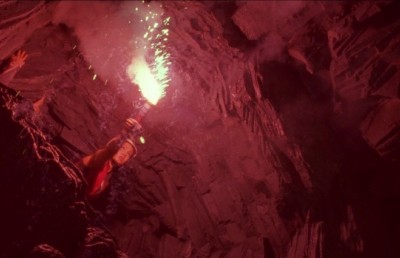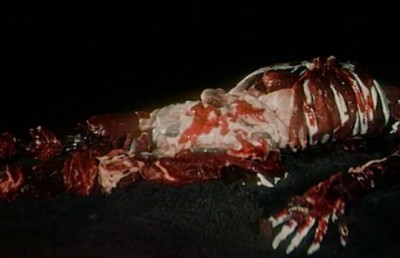Fantasia 2006: 10th Year Anniversary
Men That Kill
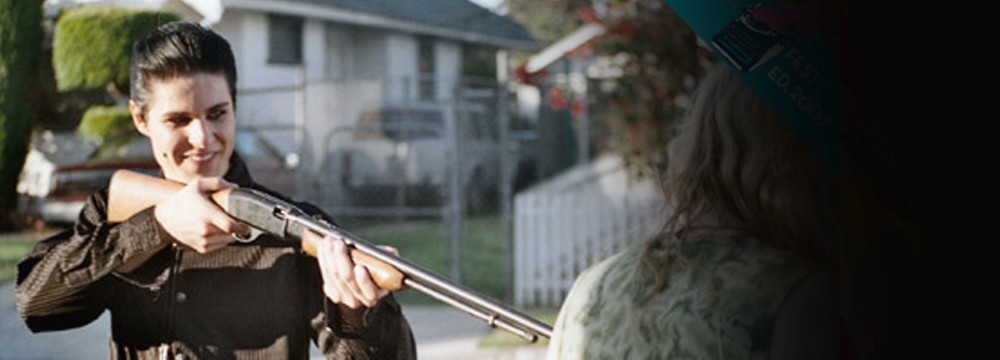
It is hard to believe that ten years have already elapsed since the first edition of Fantasia. In those first few years people close to the festival were amazed at the line-ups that snaked around street corners. The long cues are now par for the course, though the festival organizers go to great pains to acknowledge the importance of the fan, and underscore how much it remains a festival by fans for fans. Ten years and still going strong, strong enough to have become the largest (in terms of tickets sold) genre festival in North America.
Ten years older, but people still come to Fantasia for the same reason: to see cutting edge alternative genre cinema that challenges, entertains and shocks. Fantasia fans have come to at least expect the latter –shock– as minimum. And this year much of the ‘shock’ value came in the shape of one of the several ‘strands’ I noticed at Fantasia 2006: films sporting a psychotic or emotionally unstable lead male character that inflicts sadistic pain onto others and/or kills. Of course pointing out that psychotic, sociopathic, sadistic, sick murders are plentiful among the characters stretched across a Fantasia film lineup is not exactly a revelation. However, the mix seemed particularly interesting this year with respect to the social and economic variety of the villains –ranging from poor/working class to aristoctratic– and the stylistic representations of the films in general.
Edmond (2005), directed by someone whose filmography is well known to most Fantasians, Stuart Gordon, is a hermetic study of a male mid-life crisis. The film is based on David Mamet’s one-act play from 1982, and, while hampered by the inherent staginess of the material, remains a fascinating examination of one man’s slow emotional disintegration. Gordon’s own background in experimental theatre in Chicago, and indeed, his direction of the 1974 Mamet play Sexual Perversity in Chicago, puts him in good standing as the director of Edmond. It is also interesting seeing how well matched the politics and social ideology of a play made during the Reagan 1980s (right wing anger, narcissism, misogyny, fear of the ‘other’) is transposed to the current Bush era. Matching the character Edmond Burke’s (William H. Macy) downward spiral is an overall style which begins realistically and then slowly veers away from realism to hyperbole and absurdism, ending with a scenario which could best be described as the character’s own worse nightmare. Burke’s male rage, directed mainly at women (first his wife, a waitress, and a series of prostitutes), but also blacks and gays, and his inevitable act of violence gets turned inwards as he is arrested for the murder of a young waitress (Julia Stiles) and ends up in prison as the meek sex slave of a physically stronger black prisoner (he becomes a victim of his own social Darwinism). The dynamics of the narrative is reminiscent in the general sense of other fairly recent studies in male social anger –Gaspar Noe’s brilliant I Stand Alone and its short precedent Carne and the less brilliant Falling Down (1993, Joe Schumacher), and the similar film from an earlier era, Joe (1970, directed by John Avildsen, starring Peter Boyle as a working class bigot).
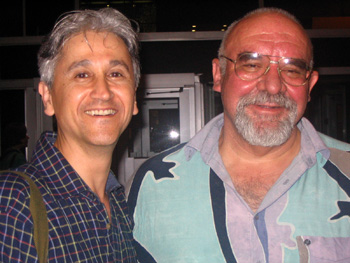
Edmond??’s opening break-up scene is reminiscent of another (and far greater) study in marital/mid-life crisis, John Cassavetes’ ??Faces (1965), where John Marley returns from work to curtly announce to his wife Lynn Carlin that he wants a divorce. In both cases the decision to break-up comes as a great shock to the wife; only in Faces the film’s time is shared between male and female responses to the breakup, while in Edmond we only get the male perspective.
As frightening as the mid-life, middle class Edmond was, one of the more frightening sickos at this year’s Fantasia was the 19-year old, wholesome looking, working class honcho Ray Pye (Marc Senter) in The Lost (Chris Sivertson, 2005); perhaps it is because of his youth, and the realisation that, potentially, he has a lifetime of terrorizing and murdering ahead of him. The film opens with an unsettling scene in the woods –partially recalling the gut wrenching woods scene in Last House on the Left. It begins with the camera tracking cowboy boots making their way to an outhouse, out of which emerges a young, nude woman (Erin Brown, alias Misty Mundae). Pye looks at the surprised and embarrassed woman as if Christmas has come early, and the uncomfortable moment briefly dissipates as she excuses herself and returns to her single female friend. Pye returns the news of his discovery to his girlfriend Jen (Shay Astar) and friend Tim (Alex Frost). Egged on by Pye, Jen and Tim become accomplices in the double murder of the two women. From this point on the film becomes more of a psychological study of a disturbed young man whose emotional insecurities, which range from his height –he walks around with crushed cans in his shoes to increase his height, but which ironically make him walk with a Freudian limp– his sexual prowess, his looks, his manhood, his status as alpha male, push him toward acts of senseless misogyny, cruelty and violence.
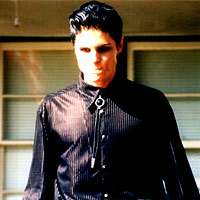
The narrative moves ahead four years, with the murders unsolved, and introduces a new set of characters and dynamics: Detective Charlie Schilling (Michael Bowen) and his ex-partner, Ed Anderson (Ed Lauter), the latter having a relationship with a woman young enough to be his daughter, Sally Richmond (Megan Henning); and a new girl in town who seems like Ray’s female alter ego, Katherine Wallace (Robin Sydney). The film withholds its violence until the finale, instead building characterisation, which serves to make Ray’s extreme violent outburst at the end –which makes the climax of Straw Dogs feel tame– all the more affective. Although the film draws its sensibility and some of its characterisation from American Psycho (Pye’s infatuation with his looks and his narcissism recalls Christian Bale’s Richard Bateman), Wild at Heart and Badlands (the dangerous coupling of Pye and Katherine), its ‘timeless’ setting makes it a relevant and powerful study in what happens when youthful anger is turned inward and violent.
The slow, mental breakdown we see Pye undergo also occurs to the male killer in Donald Cammell’s White of the Eye which, along with the other retro title screened, Viy (1968), was the highlight of the festival for this viewer. The big difference is that the serial killer in White of the Eye (Paul White) is all of the things that Pye aspires to: virile, intelligent, mysterious, and, most definitely, the alpha male to the secondary character Mike Desantos (Alan Rosenberg). White of the Eye is a fascinating and unique blend of serial killer and giallo, which opens with a highly stylized murder of a woman in her chic high rise apartment with nods to the giallo (the precise framing and art design, aggressive music) and Argento (the victim’s head is thrust through the window pane of a microwave, recalling a similar murder in Suspiria).
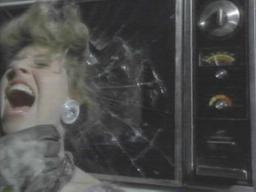
The first forty or so minutes of White of the Eye is pure cinematic electricity, with infectious prog rock music from Nick Mason and Rick Fenn and the kinetic energy that comes from a constant interplay between fluid camera movements and an elliptical montage that moves the narrative from the present to the past with flashbacks –which are shot in grainier stock and with a hint of blue– of when Paul and his wife Joan White (Cathy Moriarity) first met; and the formative male terrain battles between Paul and his wife’s former boyfriend Mike. I was not surprised to learn from the excellent critical biography of Donald Cammell, Donald Cammell: A Life on the Wild Side, which was launched at Fantasia by publisher Harvey Fenton of FAB press in company of its co-authors Sam and Rebecca Umland, that most of the film was shot with a steadicam by operator Larry McConkey (“I think virtually the entire film was shot on Steadicam,” quote from Cassian Elwes, p. 226).
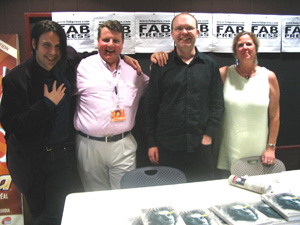
The fluid, disembodied nature of the camera movements are an apt correlative for the film’s flight motif (shots of eagles in flight, aerial point of view shots, extreme close-ups of bird eyes, etc.). Much of the film’s energy comes from the outstanding use of music and sound, with the original music by Mason and Fenn complemented by shifts in musical styles according to the time period of the flashbacks (roughly, the late 1970s). The killer Paul White is also a complex character constructed out of a Cammellian blend of post-1960’s psychedelic/spiritualist iconography. When Paul is first seen in flashback, from Joan’s point of view, he comes walking out of a field of blinding white light like some demi-god, with a striking hair style and Native American beads. In the flashbacks where he goes hunting for deer with Mike he appears like a savage, killing with his bare hands, drinking the blood of his catch and ritualistically kissing Mike on the lips. In the film’s climax, where he tries to kill Joan and Mike in an abandoned mine, he is dressed as a cross between a samurai (hair in a ponytail) and a part green beret, part Apache warrior (face paint).
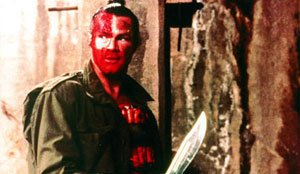
Paul is also an ‘artist’ at several interconnected levels. To begin, he works in ‘sound,’ installing high end stereo systems in rich homes. While driving he is seen listening and singing along to the opera Pagliacci, and in a flashback is introduced by his grandfather as a ‘master of the transistor.’ At a more abstract level he is the archetypical “murderer-as-artist” with his self-conscious and obsessive behaviour (he collects body parts from his victims like trophies). For example, when he drowns a victim in her bathtub he places a hand mirror to her submerged face so she can see her dying face (an hommage to Peeping Tom, a classic ‘murderer-as-artist’ film). When detective Mendoza (Art Evans) arrives at the scene of the first murder (described earlier) he finds blood splashed on the wall in the shape of an abstract expressionist painting and a body part placed in a small pot on the kitchen table with four knives ritualistically lined up around the pot. As the detective states, “I know a work of art when I see one!”
The latter can be seen as part of a critical distinction made by Steven Schneider in his essay “Murder as Art/The Art of Murder: Aestheticising Violence in Modern Cinematic Horror” (Intensities: The Journal of Cult Media 3, Spring 2003) between two forms or representations of ‘murder as art’: when the artistic designs of the murders are a result of the director’s cinematic style (“diegetic set designer”); and when the artistic designs of the murders are a result of the artistic aspirations on the part of the actor/murderer (director-as-artist vs. murderer-as-artist). At times, as in White of the Eye, it functions as a combination of the two forms.
This notion of ‘murder as art,’ while not a new one (Schneider cites several seminal films, including Peeping Tom, The Texas Chainsaw Massacre, Manhunter, Seven, A Clockwork Orange, and Theatre of Blood), has taken on a particular characteristic in recent years, which was also in evidence at this year’s Fantasia: films where the murderer designs and orchestrates the precise manner in which the narrative progresses and the victims die. This can take on the form of a ‘narrative within the narrative’ where the construct is that we are watching the film as it is/was made by the killer (The Last Horror Movie, 2003 Julian Richards and Man Bites Dog, 1992, Rémy Belvaux); or where the killer ‘directs’ the proceedings from within the narrative (the Saw films are an example).
At this year’s Fantasia there were three films that fell into the former category of films which are structured primarily as if we are seeing a film made by the narrative killer: Alone With Her (Eric Nicholas, 2006), 39: A Film by Carroll McKane (2006 Gary Sherman), and (to a different degree) Behind the Mask: The Rise of Leslie Vernon (Scott Glosserman, 2006). In the latter case, a clever parody of the stalker film in the shape of a mockumentary, a documentary crew led by eager young female documentarian Taylor Gentry (Angela Goethals) is invited to record the life and times of up and coming serial killer Leslie Vernon (Nathan Baesel). In a world where fictional killers Jason, Michael Myers, and Freddie Krueger are heroes to Vernon, the crew follow Vernon around as he stalks, reveals ‘trade secrets,’ and his desire to become the ‘greatest’ of them all. The crew slowly paint themselves into a moral corner when Vernon orchestrates a typical stalker film scenario which he can exploit –a group of teenagers partying in an abandoned country house– and then must decide whether to remain objective and not intrude on Vernon’s plan, or interfere for the sake of saving lives. At this point the film switches gears and draws on the same stalker film conventions it had parodied thus far.
The killer with illusions of grandeur also appears in Gary Sherman’s nervy ‘murderer-as-artist’ film 39: A Film by Carroll McKane. The majority of the film takes place inside the titular Carroll McKane’s killing room, where he holds two victims and a forensic psychiatrist named Dr. Martin L. Selby (Lawrence MacGowan) hostage to his well orchestrated plan of egotistical destiny making. Along with being a killer, McKane (Martin Cummins) is an amateur videographer, having recorded the death of each of his 36 victims and equipping his killing room with several small digital cameras strategically placed to film his hostage/victims from all angles. After dispatching the couple as victims number 37 and 38 McKane delves into the deep psychological terrain of orchestrating the demise of victim number 39: himself. We learn that McKane has kidnapped and tortured the psychiatrist not to murder him, but for the purpose of having him become his ‘official’ biographer and documentor. The psychiatrist resists being an accomplice in his egotistical scenario, but falls to McKane’s devious set-up, which includes showing Dr. Selby extreme camera footage of him holding his wife and daughter hostage, which gets Dr. Selby so angry that he temporarily loses his reasoning shackles and murders McKane. One of the joys (if that is the right word?) of this film is the fascinating dialogue exchanges between McKane and Dr. Martin L. Selby, which reveals just how much research Sherman conducted into the phenomenon of serial killing (in his introduction to the film Sherman talked about his fascination with serial killing and how he has read everything he could get his hands on about the subject). The other impressive aspect of the film is how well it manipulates the initial construct of seeing everything as if filmed by one of McKane’s digital cameras. As Sherman revealed after being prompted by a question during the post-film Q & A, there is a subtle change in editing style about two-thirds of the way into the film, which is an important clue to the film’s narrative structure and ‘video diary’ format. According to Sherman, the first two-thirds of the film is seen as if edited by the killer Carroll McKane, and the last third of the film as if edited by Dr. Selby (who survived) and the police.
Another film which takes the ‘video diary’ format to an even more extreme degree is the impressive second feature by Eric Nicholas, Alone With Her. The film opens with the following intertitles:
Every minute, three people become victims of stalking in the United States.
What concerns us most is that recent technology has created a golden age for predators to track and terrorize.
Hidden video cameras, microphones and other spy equipment can now be purchased for next to nothing and are available through the internet and retail stores everywhere ….to anyone.
David Wiseman, U.S. Department of Justice
There is little doubt that this film is a product of the post-9/11, ‘Patriot Act’ Bush era, where civil liberties are continually challenged for the sake of home land security (the separation of private from public space, the sense of one’s privacy being invaded, etc.). The film explores the potential sense of paranoia stemming from this privacy infringement, with an opening scene where we see traditional home video aesthetic images from the point of view of a video camera. In a mirror reflection we see a man camouflaging a camera inside a duffel bag.
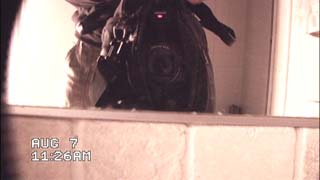
Then we get a series of voyeuristic POV shots from the hidden position inside the bag of various women being filmed without their knowledge. After settling on a beautiful young woman as his target, Ana (played by the Mexican actress Ana Claudia Talancón), stalker Doug (Colin Hanks) breaks into her home and installs hidden cameras and microphones everywhere inside her apartment, using the knowledge he gains about her personal likes and dislikes to ingratiate himself into her life (“Hey, your favorite band is Skinny too!”). The sly and underhanded manner in which the socially awkward Doug does this is repulsive and genuinely unsettling. The conceit of the film is that it is shot entirely through the stalker’s hidden cameras, including a “body cam” worn by the actor Hanks in which Ana is aware of being filmed (these shots are usually coded as black and white). Director Nichols liberates himself from the limitations of subjective point of view shots by having the stalker leave the cameras, which he controls from his apartment, running, which then allows him to enter into his own camera frames and ‘act’ in his own films. The conceit is ingeniously maintained if only for a few fleeting seconds toward the end where framing and editing are presented which move beyond the prescribed settings of the stalker’s setups (for example a swish pan when Doug is in the frame…unless he has an accomplice ‘manning’ the camera???).

The bizarre Strange Circus packages two sick males with sexual perversity and torture replacing out and out murder. Strange Circus deals with the incestuous goings on between a father (Gozo, played by Hiroshi Oguchi), mother (Sayuri, played by Masumi Miyazaki), and 12-year-old daughter (Mitsuko, played by Rie Kuwana). The father is an exhibitionist, making love with his wife while his daughter –whom he ‘hides’ in a bedside cello which contains a peephole– looks on; as if this was not perverse enough, he then switches the scenario by placing his wife in the cello and has sex with his daughter! However, any resemblances between appearance and reality soon becomes purely coincidental, as does making judgments on who is who –as director Sion implies when, after Gozo switches his sex partner from mother to daughter, the audience still sees the mother as the woman making love to the father. At roughly the half-way mark we are introduced to other characters, a wheelchair bound writer Taeko (also played by Masumi) and her unstable assistant Yuji (Issei Ishida), who replaces Gozo as the mad patriarch of the second half, at least until it is revealed that all we have seen thus far is a fiction-within-a-fiction visualisation of Taeko’s recent novel, and that Yuji may in fact be Taeko’s/Sayuri’s daughter Mitsuko (his chest sports two large self-inflicted wounds). The sexually androgynous Yuji becomes completely unhinged, kidnapping Gozo, confining him to a bed and turning him into an amputee with a chainsaw. In the film’s penultimate scene Yuji chains Taeko next to Gozo and, standing over them wielding a chainsaw, yells the film’s last prophetic line of dialogue, before the film cuts to the concluding framing device ‘circus scene’: “What’s real; and what’s not?”
Sexual perversion forms the bedrock of the sociopathic character in Neighborhood Watch, Adrien Trumbull (Nick Searcy), who gets my nod as the sickest of the male killers on display at Fantasia this year. Neighborhood Watch (2005) –which was screened in presence of its director Graeme Whifler– also stars Bob (Jack Huston) and Wendi (Pell James) as a young couple that move into a cookie-cutter suburban community because of husband Bob’s job promotion. While hoping to start a new life the couple instead become unwilling victims of neighbor Trumbell’s twisted phobias and delusions. Trumbell is a sado-masochist who takes equal pleasure in inflicting pain on himself and others. Trumbell spends the first part of the film slowly poisoning Bob and Wendi with his ‘friendly’ boxes of chocolates and performing vile acts of self-mutilation and paraphilia, which includes eating bits of feces off his stomach, masturbating while moving his finger in and out of a self-inflicted abdomen wound, and performing surgery on himself to expunge and play with various glands and intestinal body parts (think James Wood exploring his stomach vagina with a gun in Videodrome but without any of the hallucinogenic surrealism, and much, much messier). I know paraphilia can be strange, but Trumbell’s sexual fetishisms are of the highly bizarre variety. According to director Whifler, the character is a composite of two real life people he had heard or read about: a person who used various over the counter products to poison his neighbors; and another person who performed surgery on himself to remove a gland which he believed was the source of his libido. Yes, reality is often stranger than fiction! Director Whifler pulls no punches in the way this paraphilia is depicted. In fact, if the special effects (by Leonard MacDonald) weren’t as good as they are, the film would have risked becoming camp. Instead it is a nervy, effective little black (very black) comedy, with the humor coming from the film’s ability to push the audience into accepting the increasingly absurdist behavior of the central character. Neighborhood Watch also demonstrates that in today’s supposedly violence-saturated entertainment climate audiences still have a tolerance point for screen violence which directors can surpass. As director Whifler confirmed, people have fainted at several screenings of the film during its most intense moments (apparently this was the case at the Fantasia screening I was at, although I could not confirm this first hand).
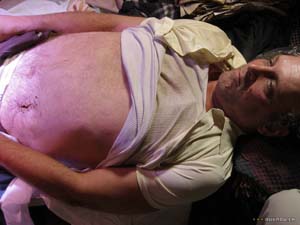
If Adrien Trumbell was the ‘sickest’ male on the Fantasia screens this year, the most pathetic ‘killer’ was the younger, mentally unhinged James Brocklebank (Leo Bill) from The Living and the Dead (Simon Rumley, 2006), programmed as part of this year’s focus on new British horror cinema. The Living and the Dead, perhaps the best new film that I saw at Fantasia this year, is an odd mixture of horror film, acid trip, and class allegory. Although some people were comparing it to Requiem for a Dream (James’ drug-induced hallucinations captured by montage sequences, pixilated fast motion, over exposed lighting, etc.), it owes as much thematically and stylistically to Joseph Losey’s 1964 The Servant (the decline of the ruling class, the struggle for male dominancy, the singular house location, the evolution of the house’s physical condition, etc.).
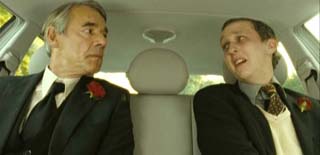
The film opens in an empty estate home, with an old, disheveled man, who we soon learn is an ex-Lord named Donald Brockleband (Roger Lloyd-Pack), waiting for an ambulance seen arriving through a living room window. The image is filmed in a lifeless blue-grey color. It then cuts back in time, with the image restored to color, to chart the events that led to the current impoverished state of this aristocratic family: Lord Donald Brockleband, his bed-ridden wife Nancy (Kate Fahy), and their mentally disturbed man child, James. Although James is unable to care for himself, he feels the need to prove himself (and challenge the father’s authority) by continually asking his father if he can look after his sick mother’s well-being. Donald leaves for a few days to London to finalize the estate sale, which marks the beginning of the end, as James promptly defies his father’s orders to leave the care-taking to the regular nurse. James locks the doors and prohibits the nurse from entering the estate, and then begins to ‘care’ for his mother in his own twisted, childlike manner (if two pills are good, then fifty would be better, so James force feeds his mother dozens of pills; he stops taking his own medicine; he bathes his mother in feces soiled tub water, etc.). The middle portion of the film, where we witness James’ psychological disintegration and the subsequent tragic (and terrifying) consequences for mother, is an intense forty or so minutes of stylized dementia. While in a drug-induced, medication deprived state, James fatally stabs his mother. The film’s only misfire is the penultimate scene of the mother’s funeral, where James stabs himself to death while imagining being in his mother’s embrace. The loss of his wife and son (and the family’s economic collapse) sends Donald into a comatose state, and brings the narrative back to the initial blue-gray scene, where he is eventually taken away in an ambulance.
As evidenced by three of the above films (Alone With Her, 39: A Film by Carroll McKane, and Behind the Mask: The Rise of Leslie Vernon), the ‘video diary’ format, no doubt influenced by the recent ‘reality television’ craze, and perhaps first used in the great ‘false’ cinema verite (different from mockumentary) Jim Holzman’s Diary (Jim McBride, 1967), has been getting some remarkable stretch of late from the horror genre (along with the above mentioned titles I would add the remarkable, partial mockumentary S&Man directed by JT Petty, 2006). As usual, none of this gets past Fantasia, which after ten years remains on the cutting edge of what is happening in the horror and fantasy genre.




